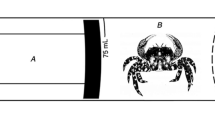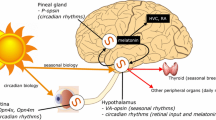Abstract
Single biweekly injections of exogenous melatonin were given to ruin lizards (Podarcis sicula) whose circadian locomotor rhythms were recorded under constant temperature (29°C) and darkness. To generate a phase-response curve the direction and amount of phase shift were plotted versus the time at which the injection was given. The results showed, for the second time in the animal kingdom, the existence of a phase-response curve for melatonin. The area under the delay part of the phase-response curve is much greater than the area under the advance part, and there is no dead zone. The phase-response curve for melatonin was generated in summer, but the repetition of experiments in autumn-winter did not generate any phase-response curve for melatonin in these seasons. In autumn-winter no one phase of the ruin lizards' circadian cycle was shifted in response to melatonin injections. This confirms several previous results in ruin lizards, showing that melatonin is centrally involved in determining circadian organization in summer and only marginally involved in autumn-winter.
Similar content being viewed by others
Author information
Authors and Affiliations
Additional information
Electronic Publication
Rights and permissions
About this article
Cite this article
Foà, A., Magnone, M. & Bertolucci, C. Circadian organization in ruin lizards: phase response curve for melatonin changes with season. J Comp Physiol A 188, 141–145 (2002). https://doi.org/10.1007/s00359-002-0285-y
Published:
Issue Date:
DOI: https://doi.org/10.1007/s00359-002-0285-y




